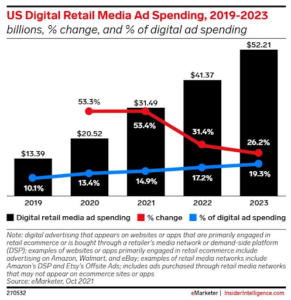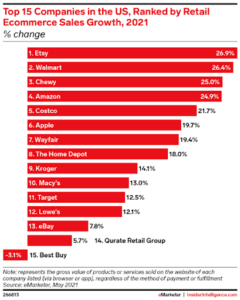
As we start the new year, here are five recommended digital marketing strategies and tactics to advance and prioritize ecommerce efforts for 2022.
Priority #1: Calculate a Breakeven ROAS at the product level
Selling on marketplaces is a marathon, not a sprint. Rarely does a seven-figure seller emerge in a matter of months. Sellers need to plan to invest a minimum of $100k+ and 6-8 months before turning a profit. Another common pitfall for brands is not managing to SKU-level profitability, favoring a blanket ROAS goal and disregarding net margin dollars. For example, hitting a $6 ROAS (17% ACOS) goal for both a $125 item and a $20 item is important, but a savvy seller understands that the additional margin dollars the $125 item yields is how they maximize profitability in a very competitive space.
Brands must understand their contribution margin (CM) at the product level and be comfortable with breakeven returns in the initial periods to stimulate sales, reviews, and organic rankings. Determining breakeven goals entails understanding the cost of goods sold (COGS), selling and shipping costs, and any 3rd party fees or commissions. Subtracting these variable costs from the average order value (AOV) provides the CM. With a little math, we arrive at a breakeven ROAS (or ACOS) and then can empower technology to utilize margin-based bidding to maximize revenue at breakeven CM levels through algorithms and ongoing optimizations. Once momentum is established, it’s time to right-size budgets for growth and profitability stages.
Priority #2: Right-size budgets (and expectations) for Amazon
Amazon will account for 78% of the retail media market spend in 2021 and their 56% growth rate outpaced the overall US digital ad market growth of 38% (eMarketer). The influx of competition from abroad and traditional companies launching direct-to-consumer (DTC) units is driving CPCs up. Amazon is courting large multinational brands as well as non-ecommerce companies (e.g. financial services) for brand building via DSP and streaming TV ads. Budgets are being drawn in from national TV buys and social media. The impending cookie depreciation and industry privacy regulations will drive more advertisers to Amazon’s closed-loop measurement and advertising platform.
To determine the right advertising budget for a product on Amazon, we must identify the highest ROAS/ACOS and conversion rate (CVR) keywords, then estimate the cost of maximizing exposure at breakeven levels to stimulate sales and ultimately organic rankings.
First, utilize tools to understand search volume, optimization benchmarks, and sales requirements for ranking. The below output is for the search query of “hot honey”:
To rank high organically for these ~7,200 monthly searches, a brand now has some comparative benchmarks for a number of reviews, pricing, revenue, and more. Like with Google, the goal is always the ‘free’ organic traffic versus having to pay for every click, but the reality is that sellers will always need both. Brands accustomed to defending their search position and conquesting from their rivals on Google must now adapt these strategies to Amazon, etc.. If a product is well optimized organically, but not getting the natural rankings, it’s likely due to low sales velocity, and paid advertising must be used to kickstart the flywheel.
Next, we need to estimate the necessary sales volume to rank above the fold on page one. For the “hot honey” query, our tool estimates ~40 products need to be sold from this keyword weekly to rank well organically, so if we’re not there, it’s time to buy our way in. Let’s assume a 10% CVR for our product, meaning we’ll need at least 400 weekly visitors to yield 40 orders. With average CPCs around $1.00, that’s a $400/week investment. At an AOV of $24, forty sales yield $960 in revenue resulting in a $2.40 ROAS (42% ACOS). This is where knowing the product-level breakeven point comes in handy, and it may require a short term loss to help spur sales and organic rankings as Amazon observes sustainability in the operational metrics (inventory, fulfillment).
As a brand compiles similar analyses for top keywords, initial budget estimates are reached and technology is employed to manage product margin goals and ultimate organic profitability.
Priority #3: Explore Marketplaces & Retail Media beyond Amazon
2022 is a chance to test marketplaces beyond Amazon. While Amazon is nearing an 80% consumer market share, ecommerce brands will encounter 99% of their competition and the majority of their digital budgets on Amazon. Amazon CPCs are rising ~30% Y/Y (MarketplacePulse). Head for greener pastures such as Walmart, eBay, or Target. Walmart and eBay have solid interfaces, good/growing ad products, and low barriers to entry. aiCommerce currently has a few clients seeing more sales and better ROAS on secondary marketplaces versus Amazon due to lower competition and CPCs. Like Amazon, success requires experience, process, and technology to maximize success.
The emerging “Retail Media” moniker is defined as digital ads that appear on retailers’ owned and operated websites and apps, as well as digital ads appearing off-site that are powered by retailers’ first-party data. From Walmart Connect to Lowe’s One Roof Media Network, major retailers are letting participating advertisers access consumer behavioral data to target and measure sales impact. Unfortunately, many retailers have not yet allowed online-only sellers on their marketplaces and require approval through traditional merchant/buyer channels with a wholesaler/1P relationship. Brands should work through retail reps and buyers for in-store shelf approval – it’s painstaking with many, but worth it!
As traditional retailers leverage their trove of omnichannel/offline data for targeting and measurement, their growing retail media offerings represent a considerable advantage over Amazon – and are cutting into Amazon’s budgets. For example, 90% of grocery sales still transact in-store and brands will seek online to offline attribution with their multifaceted media investments.
Priority #4: Build a brand
Amazon is the world’s largest price comparison engine – but can a brand compete solely on price? Especially with recent supply chain issues, many brands have found out that cheaper overseas competition is better positioned than anticipated. This said, “you get what you pay for” is not lost on today’s price-conscious consumers.
Over the past decade of digital advertising, there are numerous examples of brands who didn’t diversify into upper-funnel ad formats and watched their Google (or Facebook) CPCs rise as margins got thinner and thinner; marketplaces will be no different. Sponsored Product ads CPCs are increasing due to competition, but still driving strong returns.
Savvy consumers visit websites, IG feeds, and read reviews before purchasing to see what the brand stands for. Consumers are influenced by advertising beyond promoted product listings on results pages. Ad platforms allow targeting very specific personas and behaviors which drive measurable actions. If a brand can’t win on price, targeting lifestyle attributes, affinities, and behaviors becomes more important.
People pay more for brands – just ask Apple, GoPro, Nerf, or Mercedes. Reliability, customer service, quality, lifestyle attributes, etc. matter. A common pitfall for most ecommerce-first brands is over-focusing on advertising at the product level at the expense of lower converting, upper-funnel ad types. Product advertising is an important part of the mix, but shouldn’t represent the entire mix. Successful companies will build a brand, cross-sell, and measure life-time value (LTV); Amazon does make some of that difficult, but aspects are improving. For example, Amazon’s Connected TV has the potential to disrupt TV advertising as we know it via targeting, segmentation, interactivity, and closed-loop sales attribution. 2022 is the time to test DSPs and Retail Media Networks as well as insert Marketplace storefronts into Search and Social campaigns…
Priority #5: Direct “traditional” digital channels to Marketplaces
Brands historically have preferred directing their digital ad campaigns (e.g. Google, Facebook) to their websites to avoid 3rd party marketplace commissions and to own the relationship with the consumer (and their 1st party data!). Marketplaces tend to have 3-10x the conversion rate (~10% average CVR) with similar CPCs. Used in tandem, Facebook and Google traffic can help increase the velocity of marketplace sales and positive reviews – two major drivers of organic algorithms/rankings.
Our clients have certainly seen a boost from organic Amazon rankings and overall sales when bringing in outside traffic. The Amazon Attribution beta now provides ROI feedback on these tactics as well. When launching new products, new marketplaces, or a higher converting click, test pairing “traditional” digital channels with marketplaces to help spur revenue.
In conclusion, 2022 will see digital marketing continue to age in dog years, where every one year really equals seven. Test smart opportunities, embrace change, and partner with like-minded entrepreneurs!
More About aiCommerce
aiCommerce is a global digital marketing agency with a focus on retail and eCommerce marketplaces. With decades of experience, aiCommerce can help your brand grow across eCommerce channels to gain brand awareness and increase sales, all backed by our 90-day guarantee. Now is the perfect time to utilize our eCommerce experts to help grow your business. Click the button below to qualify for a free listing audit from aiCommerce to jumpstart your eCommerce growth!





